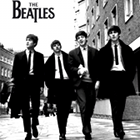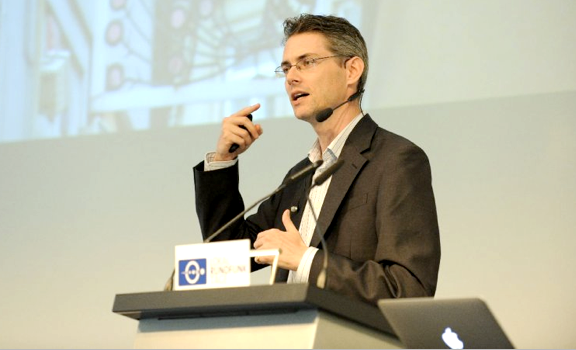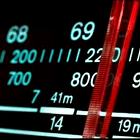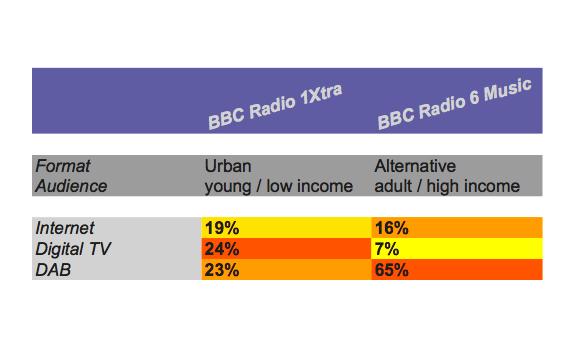Digital radio shows great opportunities for brand extension on multiple platforms. If it’s done consistently and according to the target demo’s listening habits.
Part 1 covered industry wide efforts to service radio audiences, and the importance of tagging and transcribing radio content to profit from search engine traffic. James Cridland also spoke about ways to enhance radio brands through new technology and about the future of radio distribution. I’ve captured the headlines for you.
More stations, more sales
Absolute Radio used to be one radio station in the UK. Today they have 5 extra channels on DAB and the Internet. According to Cridland, 40% of Absolute Radio’s total listening is done to their additional stations. Producing them is cheap because they run on voice tracks by the jocks of the main station. “The important thing is to sell every commercial for the whole network. Don’t go out and sell advertising for little stations by themselves because no one is interested.”
 Pop up radio stations
Pop up radio stations
A new development are so-called pop up stations. They exist for a limited period of time and for a specific reason. Australian public broadcaster ABC once launched ABC Beatles (commemorating the 40st anniversary of the Fab Four’s break up) and during the flood in Queensland, their local station there was simulcast nationwide on DAB on the QLD Floods channel. “This is new technology, making radio more relevant in times of emergency.”
Different formats, one brand
The UK radio industry learned a lesson from the early days of Digital Audio Broadcasting. “We stupidly launched lots of new stations and gave them all brand new names, like Arrow, Core and Chill. Nobody had any idea what these were about”, Cridland says. Today everyone knows that you need to consistently brand radio stations under the main master brand. For example: BBC Radio 4 Extra, featuring more programs and archive material of the mother station BBC Radio 4.

“We should use new technology not only to cut down costs, but also to connect more with our audience and be more relevant to people’s lives”, says British radio expert James Cridland (photo: Lokalrundfunktage)
Internet only: radio’s future?
James Cridland thinks that “Internet radio is very difficult if you’re going to run an entire business on it” and that terrestrial broadcast radio will remain to be the major platform for at least 10-15 years. Research shows that Internet still accounts for a very small amount of radio listening in markets all over the world. One of the reasons for the UK radio industry to invest in the recently launched Radioplayer (see part 1).
 FM radio still rules
FM radio still rules
The current market shares per radio platform in the UK are:
Internet – 3.6%
Digital televison – 4.1%
DAB – 16.7%
FM – 75.6%
Younger listeners, new platforms
BBC Radio 1Xtra (young urban music) and BBC Radio 6 Music (adult alternative music) share exactly the same digital radio platform. Both are broadcasting nationwide on DAB and digital television, and worldwide on the Internet. But their audiences use these sources very differently. 1Xtra’s young urban audience has a lower income, and sometimes can’t afford a digital radio, computer or even a smart phone. But teens usually have a TV in their room that they use as a digital radio. The older, rich and sophisticated audience of 6 Music apparently loves (the digital equivalent of) a traditional radio receiver:

BBC Radio 1Xtra and BBC Radio 6 Music share exactly the same digital radio distribution platform, but the two target demos use digital radio devices differently. Percentages do not add up to 100% because of a great number of people who answered ‘I don’t know’ when they were asked how they listen to a particular station (graphic: Thomas Giger)
Multi platform, hybrid radio
“The future of radio isn’t a binary decision between Internet, FM, DAB, DAB+, HD Radio or anything else”, says James Cridland. “The future of radio is multi platform.” The ideal radio is a receiver for every form of broadcasting and narrowcasting and can even recommend new content based on what you have been listening to before. It’s a chance for stations because “different ways of broadcasting radio means different ways to get to your audience.”
 Technologies come, people stay
Technologies come, people stay
“The future of radio more than ever needs people. We should use new technology not only to cut down costs, but also to connect more with our audience and be more relevant to people’s lives. With new technologies, radio has a bright and happy future. I believe there’s never been a better future for radio that the time we have before us now. A future where listeners will be happy, wherever they get their audio.”
Read also: James Cridland: Radio Needs One Voice





Add Your Comment